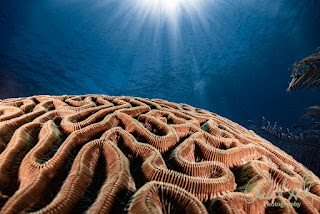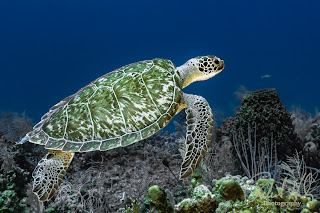Mastering the Art of Underwater Photography: 20 Pieces of Advice to Reconsider
Introduction:
Welcome to the mesmerizing world of underwater photography, where every dive unveils a kaleidoscope of colors, textures, and marine life. While seeking advice is essential for honing your skills, it's crucial to recognize that not all recommendations are one-size-fits-all. In this blog, I will explore some common pieces of advice that underwater photography enthusiasts might encounter but should consider re-evaluating. Let's dive in!1. Shoot in Manual Mode: While manual mode provides control, consider experimenting with semi-automatic modes like aperture or shutter priority. These modes allow for quick adjustments, freeing you to focus on composition and the dynamic underwater environment. It's important to learn what each of the points of the Exposure Triangle (ISO, Aperture, and Shutter Speed) do and when and where they are best used.
2. Vary Your Shutter Speeds: Don't limit yourself to fast shutter speeds. Experiment with slower speeds to capture the graceful motion of fins or the play of light on the water, especially when aiming for creative effects like motion blur.
3. Embrace All Hours of the Day: Underwater environments have unique lighting challenges. Explore shooting during different times of the day to unveil diverse marine life behaviors and capture the underwater world's full spectrum, from dawn to dusk. Bright sunny days and shallow depths allow you to use natural light, while dark overcast days allow you to use your flash or light to highlight your subject against darker backgrounds. Experiment with all types of daylight and depths to improve your skills.
4. Optimal ISO Settings: Balancing ISO with aperture and shutter speed is crucial. Higher ISO settings may be necessary in low-light scenarios. Find the right balance for well-exposed images capturing elusive or fast-moving subjects. Remember that the higher the ISO, the greater the chance of introducing noise into your photographs. Find out at what ISO, your camera starts to introduce too much noise for you.
5. Strobe Strategies: Built-in flashes can create backscatter. This is because the flash is located close to the lens and highlights all the sentiment in front of the subject matter. Experiment with external strobes to control lighting and reduce backscatter. With External Strobes, it's important to learn how to correctly point and position them to reduce the backscatter. Natural light can also be an effective alternative when conditions permit.
6. RAW vs. JPEG: While RAW provides flexibility, high-quality JPEGs can be suitable, especially for storage and processing efficiency. Experiment with both formats to find the right balance for your workflow. Remember, that if you plan on doing any kind of post-processing, it is recommended that you use RAW format. Many modern cameras come equipped with the feature to capture photos in both RAW and JPEG formats simultaneously. However, it is important to keep in mind that this dual-mode format will require a significantly larger amount of storage space in your camera.
7. Master White Balance: Custom white balance settings or manual adjustments can correct color casts. Experiment with different settings to achieve accurate and vibrant results in various underwater conditions. Cameras of today, do a great job of correcting white balance using the "Underwater Mode", but as you get deeper in the water column, they seem to lose capability. This is one of the reasons that post-processing is important. It is very easy to adjust the white balance in most post-processing applications and allows you to focus on composition and your subject.
8. Explore Different Shooting Angles: Experiment with shooting from above, below, or diagonally to capture unique perspectives and behaviors. Don't limit yourself to eye-level shots. You will find that different shooting angles will help determine your personal shooting style.
9. Capturing Murky Waters: Murky or green water can still offer unique photographic opportunities. Experiment with creative lighting, angles, and post-processing techniques to enhance images taken in challenging conditions.
10. Autofocus Adaptations: Continuous autofocus may struggle in low-contrast underwater environments. Experiment with single autofocus or manual focus to ensure sharp images, especially in situations with minimal contrast.
11. Beyond Big Marine Life: Underwater photography isn't just about capturing big marine life. Explore macro photography to appreciate the beauty of small creatures, coral formations, and intricate details. Macro photography is great when doing night dives or when water is murky or has lots of sediment in the water.
12. Aperture Versatility: Don't always shoot with the widest aperture. Experiment with different apertures to balance sharpness and depth, ensuring both subject and environment are well-defined. I prefer to shoot mostly in wide aperture settings to ensure that both the subject and the foreground and background are all in focus. I then use post-processing AI to determine what parts of the image I want to focus on and what parts I wish to blur or adjust the lighting on. This for me is my style, and might not be for others.
13. The Art of Black and White: Black and white underwater photography can be powerful. Experiment with converting shots during post-processing to add a timeless and artistic dimension to your portfolio. Remember, that Black and white allows for greater contrast than color. I use back and white on Shipwrecks and silhouettes. On wrecks, this adds mystique and a sense of age to the photos.
14. Consider the Foreground: Including an interesting foreground in wide-angle shots can add depth and context. Experiment with coral formations, rocks, or other elements to create more immersive compositions.
15. Beyond Eye Level: Experiment with shooting from different angles to capture dynamic and creative results. Don't limit yourself to eye-level shots of marine life. I find that with my style of shooting, I prefer to mostly shoot from below my subjects, but you must experiment to find out what works for you.
16. Human Element Inclusion: Include divers, snorkelers, or models in your shots for scale and storytelling. Experiment with incorporating the human element to create more relatable and engaging photographs.
17. Breaking Composition Rules: Breaking composition rules intentionally can lead to more unique and visually striking images. Experiment with unconventional compositions to add a creative and personal touch.
18. Manual Focus Mastery: Experiment with manual focus, especially in macro photography, to ensure precise control over focus, resulting in sharper and more intentional images.
19. Ethical Considerations: Respecting marine life and the underwater environment is paramount. Ignoring ethical considerations ensures a sustainable and responsible approach to underwater photography. Remember, not to move or touch anything underwater. Also, be aware of the intensity of your lights or strobes on the marine life you are capturing. Do not overlight marine subjects.
20. Varying Focal Lengths: Different subjects may benefit from varying focal lengths. Experiment with different lenses to capture the diversity of underwater environments.
Conclusion: In the enchanting realm of underwater photography, the journey to mastery involves continuous exploration and adaptation. While these pieces of advice offer valuable insights, remember that flexibility and creativity are your greatest allies beneath the waves. As you embark on your underwater photography adventures, embrace the opportunity to challenge conventions, refine your techniques, and capture the breathtaking beauty that lies beneath the surface.
For more in-depth insights and underwater photography tips, stay tuned for our upcoming blogs. Happy diving and shooting!
I am eagerly anticipating your valuable feedback and suggestions.
Sincerely,
Bob Herb
|
|





Comments
Post a Comment
Please let me know your comments.